Virus Adaptation and Selection Following Challenge of Animals Vaccinated against Classical Swine Fever Virus
Abstract
:1. Introduction
2. Materials and Methods
2.1. Vaccine and Challenge Virus
2.2. Vaccination and Challenge Infection of Animals
2.3. RNA Extraction and NGS
2.4. Analysis of Sequence Data
3. Results
3.1. Vaccinated Pigs Are Protected against Challenge with CSFV but Display Transient, Low Levels of Viral RNA in Blood
3.2. Deep Sequencing of Virus in the Challenge Inoculum Shows a Heterogeneous Population with a Consensus Sequence Identical to the Koslov Reference
3.3. Analysis of CSFV Sequences in Naïve and Vaccinated Animals Following Challenge with the Koslov Strain
3.4. Loss of CSFV Population Heterogeneity and Targeted Positive Selection was Observed in the Vaccinated Pigs
4. Discussion
Supplementary Materials
Author Contributions
Funding
Acknowledgments
Conflicts of Interest
References
- Drake, J.W. Rates of spontaneous mutation among RNA viruses. Proc. Natl. Acad. Sci. USA 1993, 90, 4171–4175. [Google Scholar] [CrossRef] [PubMed]
- Simmonds, P.; Becher, P.; Bukh, J.; Gould, E.A.; Meyers, G.; Monath, T.; Muerhoff, S.; Pletnev, A.; Rico-Hesse, R.; Smith, D.B.; et al. ICTV Virus Taxonomy Profile: Flaviviridae. J. Gen. Virol. 2017, 98, 2–3. [Google Scholar] [CrossRef] [PubMed]
- Floegel-Niesmann, G.; Blome, S.; Gerss-Dulmer, H.; Bunzenthal, C.; Moennig, V. Virulence of classical swine fever virus isolates from Europe and other areas during 1996 until 2007. Vet. Microbiol. 2009, 139, 165–169. [Google Scholar] [CrossRef] [PubMed]
- Smith, D.B.; Meyers, G.; Bukh, J.; Gould, E.A.; Monath, T.; Scott Muerhoff, A.; Pletnev, A.; Rico-Hesse, R.; Stapleton, J.T.; Simmonds, P.; et al. Proposed revision to the taxonomy of the genus Pestivirus, family Flaviviridae. J. Gen. Virol. 2017, 98, 2106–2112. [Google Scholar] [CrossRef]
- Topfer, A.; Hoper, D.; Blome, S.; Beer, M.; Beerenwinkel, N.; Ruggli, N.; Leifer, I. Sequencing approach to analyze the role of quasispecies for classical swine fever. Virology 2013, 438, 14–19. [Google Scholar] [CrossRef] [Green Version]
- Fahnøe, U.; Pedersen, A.G.; Dräger, C.; Orton, R.J.; Blome, S.; Höper, D.; Beer, M.; Rasmussen, T.B. Creation of functional viruses from non-functional cDNA clones obtained from an RNA virus population by the use of ancestral reconstruction. PLoS ONE 2015, 10, e0140912. [Google Scholar] [CrossRef]
- Fahnøe, U.; Pedersen, A.G.; Risager, P.C.; Nielsen, J.; Belsham, G.J.; Höper, D.; Beer, M.; Rasmussen, T.B. Rescue of the highly virulent classical swine fever virus strain “Koslov” from cloned cDNA and first insights into genome variations relevant for virulence. Virology 2014, 468, 379–387. [Google Scholar] [CrossRef]
- Vignuzzi, M.; Stone, J.K.; Arnold, J.J.; Cameron, C.E.; Andino, R. Quasispecies diversity determines pathogenesis through cooperative interactions in a viral population. Nature 2006, 439, 344–348. [Google Scholar] [CrossRef]
- Morelli, M.J.; Wright, C.F.; Knowles, N.J.; Juleff, N.; Paton, D.J.; King, D.P.; Haydon, D.T. Evolution of foot-and-mouth disease virus intra-sample sequence diversity during serial transmission in bovine hosts. Vet. Res. 2013, 44, 12. [Google Scholar] [CrossRef]
- Rasmussen, T.B.; Risager, P.C.; Fahnøe, U.; Friis, M.B.; Belsham, G.J.; Höper, D.; Reimann, I.; Beer, M. Efficient generation of recombinant RNA viruses using targeted recombination-mediated mutagenesis of bacterial artificial chromosomes containing full-length cDNA. BMC Genomics 2013, 14, 819. [Google Scholar] [CrossRef]
- Tamura, T.; Sakoda, Y.; Yoshino, F.; Nomura, T.; Yamamoto, N.; Sato, Y.; Okamatsu, M.; Ruggli, N.; Kida, H. Selection of classical swine fever virus with enhanced pathogenicity reveals synergistic virulence determinants in E2 and NS4B. J. Virol. 2012, 86, 8602–8613. [Google Scholar] [CrossRef] [PubMed]
- Thiel, J.; Peters, T.; Mas Marques, A.; Rosler, B.; Peter, H.H.; Weiner, S.M. Kinetics of hepatitis C (HCV) viraemia and quasispecies during treatment of HCV associated cryoglobulinaemia with pulse cyclophosphamide. Ann. Rheum. Dis. 2002, 61, 838–841. [Google Scholar] [CrossRef] [PubMed] [Green Version]
- Serre, S.B.N.; Krarup, H.B.; Bukh, J.; Gottwein, J.M. Identification of alpha interferon-induced envelope mutations of hepatitis C virus in vitro associated with increased viral fitness and interferon resistance. J. Virol. 2013, 87, 12776–12793. [Google Scholar] [CrossRef] [PubMed]
- Bukh, J. Animal models for the study of hepatitis C virus infection and related liver disease. Gastroenterology 2012, 142, 1279–1287.e3. [Google Scholar] [CrossRef] [PubMed]
- Bukh, J. The history of hepatitis C virus (HCV): Basic research reveals unique features in phylogeny, evolution and the viral life cycle with new perspectives for epidemic control. J. Hepatol. 2016, 65, S2–S21. [Google Scholar] [CrossRef] [Green Version]
- Leifer, I.; Blome, S.; Blohm, U.; Konig, P.; Kuster, H.; Lange, B.; Beer, M. Characterization of C-strain “Riems” TAV-epitope escape variants obtained through selective antibody pressure in cell culture. Vet. Res. 2012, 43, 33. [Google Scholar] [CrossRef]
- Beer, M.; Reimann, I.; Hoffmann, B.; Depner, K. Novel marker vaccines against classical swine fever. Vaccine 2007, 25, 5665–5670. [Google Scholar] [CrossRef]
- Rasmussen, T.B.; Uttenthal, A.; Reimann, I.; Nielsen, J.; Depner, K.; Beer, M. Virulence, immunogenicity and vaccine properties of a novel chimeric pestivirus. J. Gen. Virol. 2007, 88, 481–486. [Google Scholar] [CrossRef]
- Blome, S.; Aebischer, A.; Lange, E.; Hofmann, M.; Leifer, I.; Loeffen, W.; Koenen, F.; Beer, M. Comparative evaluation of live marker vaccine candidates “CP7_E2alf” and “flc11” along with C-strain “Riems” after oral vaccination. Vet. Microbiol. 2012, 158, 42–59. [Google Scholar] [CrossRef]
- Blome, S.; Gabriel, C.; Schmeiser, S.; Meyer, D.; Meindl-Bohmer, A.; Koenen, F.; Beer, M. Efficacy of marker vaccine candidate CP7_E2alf against challenge with classical swine fever virus isolates of different genotypes. Vet. Microbiol. 2014, 169, 8–17. [Google Scholar] [CrossRef]
- Gabriel, C.; Blome, S.; Urniza, A.; Juanola, S.; Koenen, F.; Beer, M. Towards licensing of CP7_E2alf as marker vaccine against classical swine fever-Duration of immunity. Vaccine 2012, 30, 2928–2936. [Google Scholar] [CrossRef] [PubMed]
- Eble, P.L.; Geurts, Y.; Quak, S.; Moonen-Leusen, H.W.; Blome, S.; Hofmann, M.A.; Koenen, F.; Beer, M.; Loeffen, W.L.A. Efficacy of chimeric Pestivirus vaccine candidates against classical swine fever: Protection and DIVA characteristics. Vet. Microbiol. 2013, 162, 437–446. [Google Scholar] [CrossRef] [PubMed]
- Fahnøe, U.; Höper, D.; Schirrmeier, H.; Beer, M.; Rasmussen, T.B. Complete Genome Sequence of Border Disease Virus Genotype 3 Strain Gifhorn. Genome Announc. 2014, 2, 12–13. [Google Scholar] [CrossRef] [PubMed]
- Mittelholzer, C.; Moser, C.; Tratschin, J.-D.; Hofmann, M.A. Analysis of classical swine fever virus replication kinetics allows differentiation of highly virulent from avirulent strains. Vet. Microbiol. 2000, 74, 293–308. [Google Scholar] [CrossRef]
- Rasmussen, T.B.; Reimann, I.; Uttenthal, A.; Leifer, I.; Depner, K.; Schirrmeier, H.; Beer, M. Generation of recombinant pestiviruses using a full-genome amplification strategy. Vet. Microbiol. 2010, 142, 13–17. [Google Scholar] [CrossRef] [PubMed] [Green Version]
- Leifer, I.; Hoffmann, B.; Hoper, D.; Bruun Rasmussen, T.; Blome, S.; Strebelow, G.; Horeth-Bontgen, D.; Staubach, C.; Beer, M. Molecular epidemiology of current classical swine fever virus isolates of wild boar in Germany. J. Gen. Virol. 2010, 91, 2687–2697. [Google Scholar] [CrossRef]
- Andrews, S. Babraham Bioinformatics FastQC: A Quality Control Tool for High Throughput Sequence Data. Manual. 2010. Available online: www.bioinformatics.babraham.ac.uk/projects/fastqc/ (accessed on 9 October 2019).
- Schmieder, R.; Edwards, R. Quality control and preprocessing of metagenomic datasets. Bioinformatics 2011, 27, 863–864. [Google Scholar] [CrossRef] [Green Version]
- Henn, M.R.; Boutwell, C.L.; Charlebois, P.; Lennon, N.J.; Power, K.A.; Macalalad, A.R.; Berlin, A.M.; Malboeuf, C.M.; Ryan, E.M.; Gnerre, S.; et al. Whole genome deep sequencing of HIV-1 reveals the impact of early minor variants upon immune recognition during acute infection. PLoS Pathog. 2012, 8, e1002529. [Google Scholar] [CrossRef]
- Li, H. Aligning sequence reads, clone sequences and assembly contigs with BWA-MEM. arXiv 2013, arXiv:1303.3997. Available online: http://bio-bwa.sourceforge.net/ (accessed on 9 October 2019).
- Lee, W.-P.; Stromberg, M.P.; Ward, A.; Stewart, C.; Garrison, E.P.; Marth, G.T. MOSAIK: A hash-based algorithm for accurate next-generation sequencing short-read mapping. PLoS ONE 2014, 9, e90581. [Google Scholar] [CrossRef]
- Li, H.; Handsaker, B.; Wysoker, A.; Fennell, T.; Ruan, J.; Homer, N.; Marth, G.; Abecasis, G.; Durbin, R. The Sequence Alignment/Map format and SAMtools. Bioinformatics 2009, 25, 2078–2079. [Google Scholar] [CrossRef] [Green Version]
- Wilm, A.; Aw, P.P.K.; Bertrand, D.; Yeo, G.H.T.; Ong, S.H.; Wong, C.H.; Khor, C.C.; Petric, R.; Hibberd, M.L.; Nagarajan, N. LoFreq: A sequence-quality aware, ultra-sensitive variant caller for uncovering cell-population heterogeneity from high-throughput sequencing datasets. Nucleic Acids Res. 2012, 40, 11189–11201. [Google Scholar] [CrossRef] [PubMed]
- Cingolani, P.; Platts, A.; Wang, L.L.; Coon, M.; Nguyen, T.; Wang, L.; Land, S.J.; Lu, X.; Ruden, D.M. A program for annotating and predicting the effects of single nucleotide polymorphisms, SnpEff: SNPs in the genome of Drosophila melanogaster strain w1118; iso-2; iso-3. Fly (Austin) 2012, 6, 80–92. [Google Scholar] [CrossRef] [PubMed]
- Nelson, C.W.; Moncla, L.H.; Hughes, A.L. SNPGenie: Estimating evolutionary parameters to detect natural selection using pooled next-generation sequencing data. Bioinformatics 2015, 31, 3709–3711. [Google Scholar] [CrossRef] [PubMed]
- Burwitz, B.J.; Ende, Z.; Sudolcan, B.; Reynolds, M.R.; Greene, J.M.; Bimber, B.N.; Almeida, J.R.; Kurniawan, M.; Venturi, V.; Gostick, E.; et al. Simian immunodeficiency virus SIVmac239Deltanef vaccination elicits different Tat28-35SL8-specific CD8+ T-cell clonotypes compared to a DNA prime/adenovirus type 5 boost regimen in rhesus macaques. J. Virol. 2011, 85, 3683–3689. [Google Scholar] [CrossRef]
- Andino, R.; Domingo, E. Viral quasispecies. Virology 2015, 479–480, 46–51. [Google Scholar]
- Lauring, A.S.; Andino, R. Quasispecies theory and the behavior of RNA viruses. PLoS Pathog. 2010, 6, 1–8. [Google Scholar] [CrossRef]
- Chang, C.-Y.; Huang, C.-C.; Deng, M.-C.; Huang, Y.-L.; Lin, Y.-J.; Liu, H.-M.; Lin, Y.-L.; Wang, F.-I. Antigenic mimicking with cysteine-based cyclized peptides reveals a previously unknown antigenic determinant on E2 glycoprotein of classical swine fever virus. Virus Res. 2012, 163, 190–196. [Google Scholar] [CrossRef]
- Li, Y.; Wang, J.; Kanai, R.; Modis, Y. Crystal structure of glycoprotein E2 from bovine viral diarrhea virus. Proc. Natl. Acad. Sci. USA 2013, 110, 6805–6810. [Google Scholar] [CrossRef] [Green Version]
- El Omari, K.; Iourin, O.; Harlos, K.; Grimes, J.M.; Stuart, D.I. Structure of a pestivirus envelope glycoprotein E2 clarifies its role in cell entry. Cell Rep. 2013, 3, 30–35. [Google Scholar] [CrossRef]
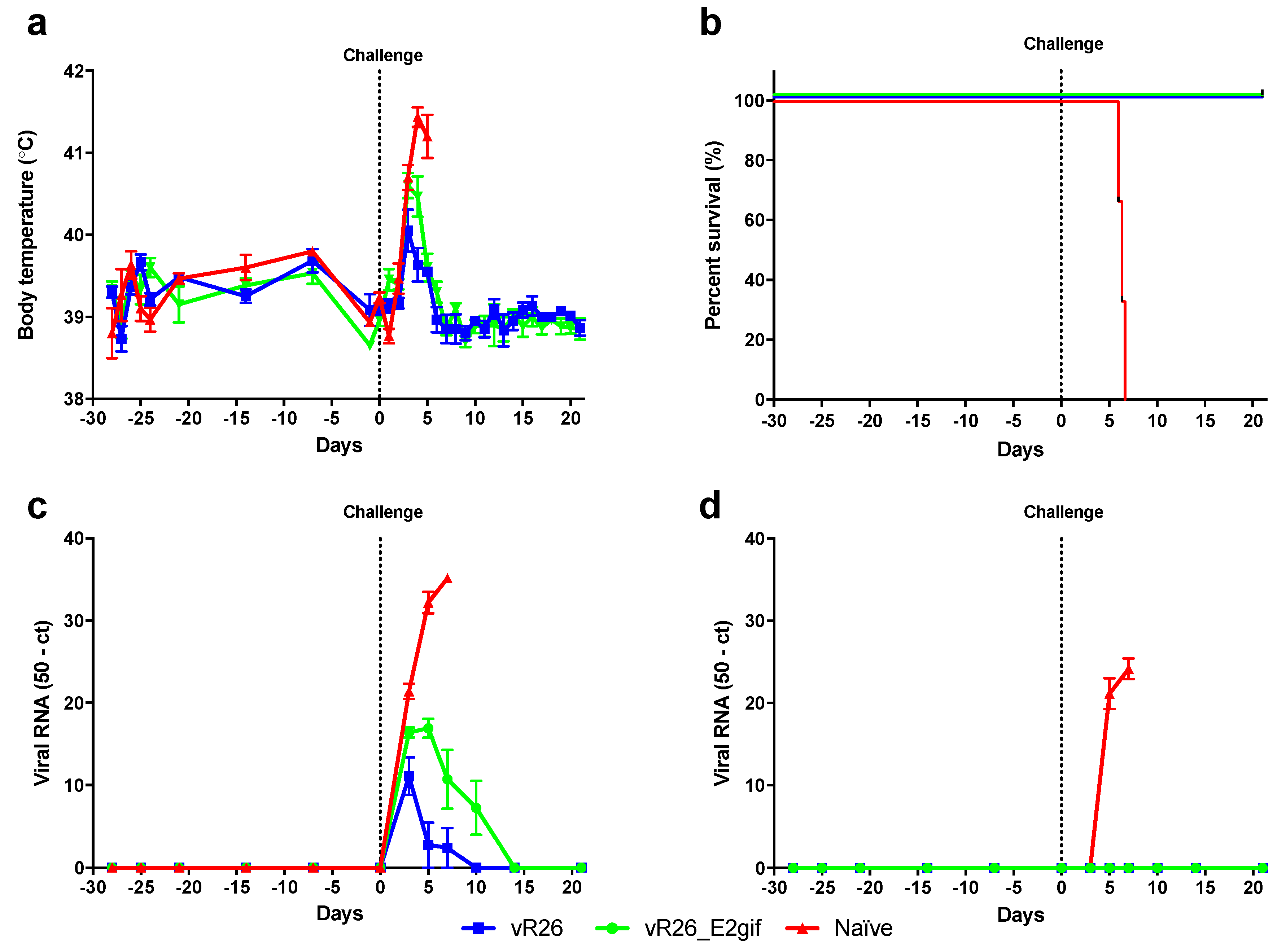
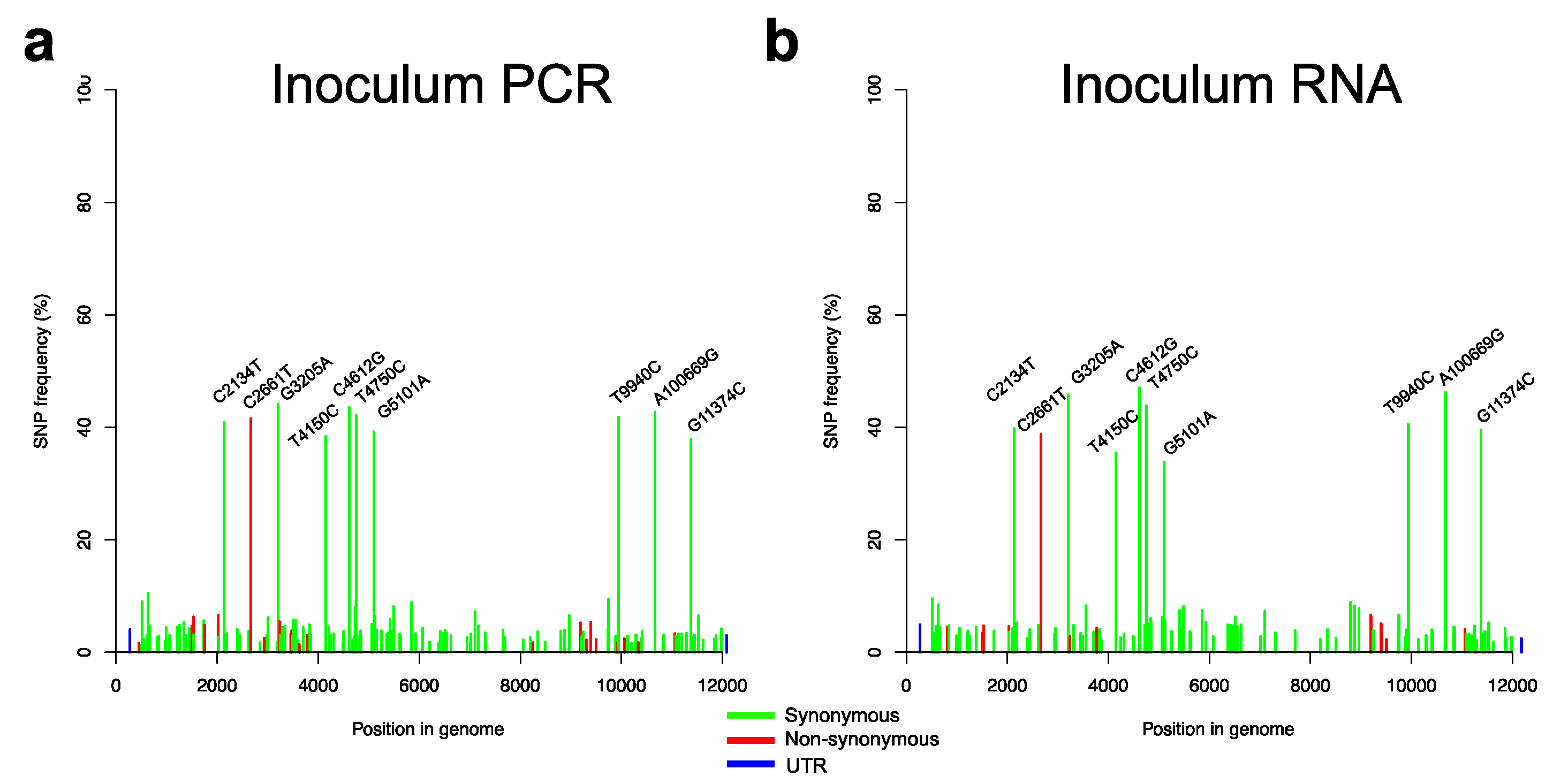

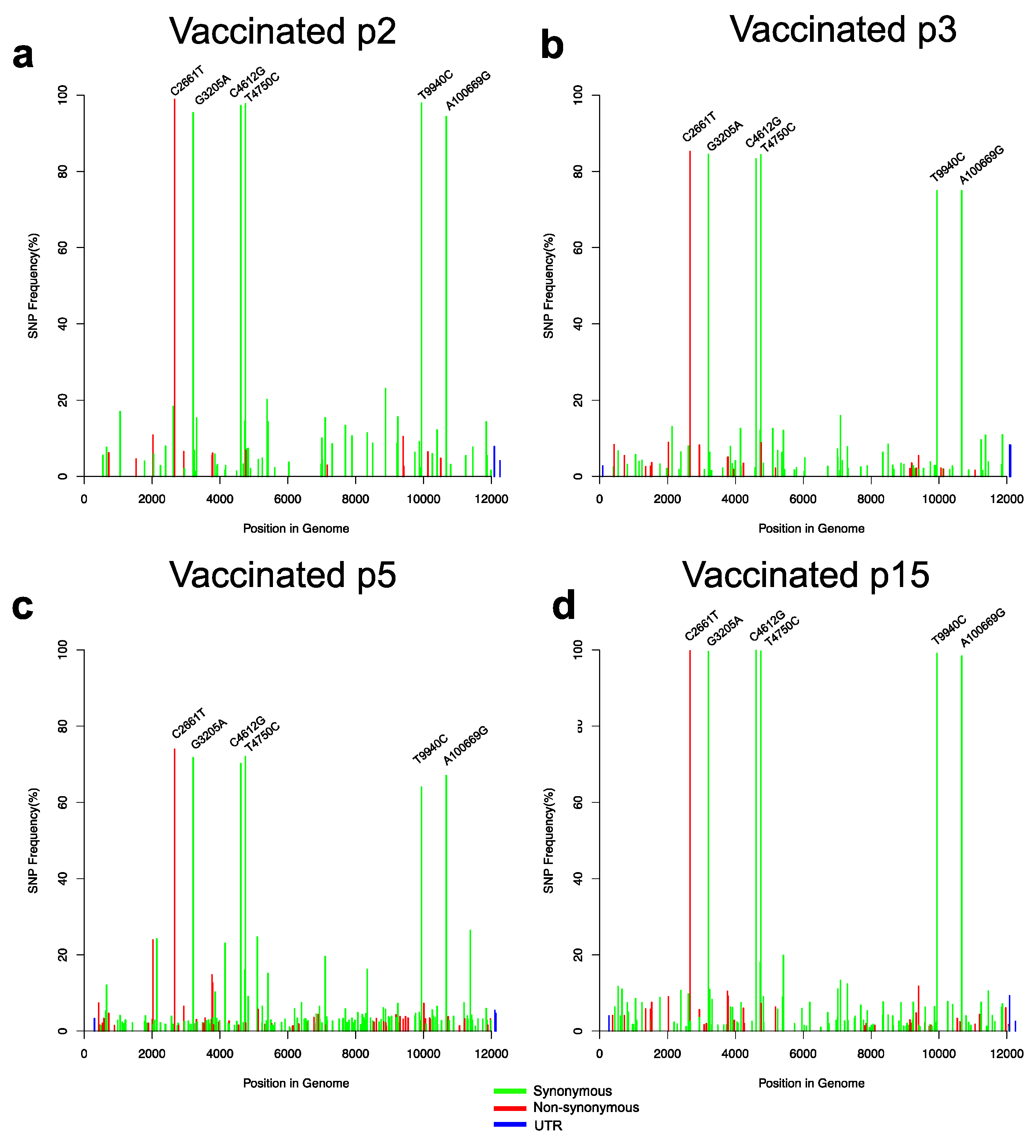
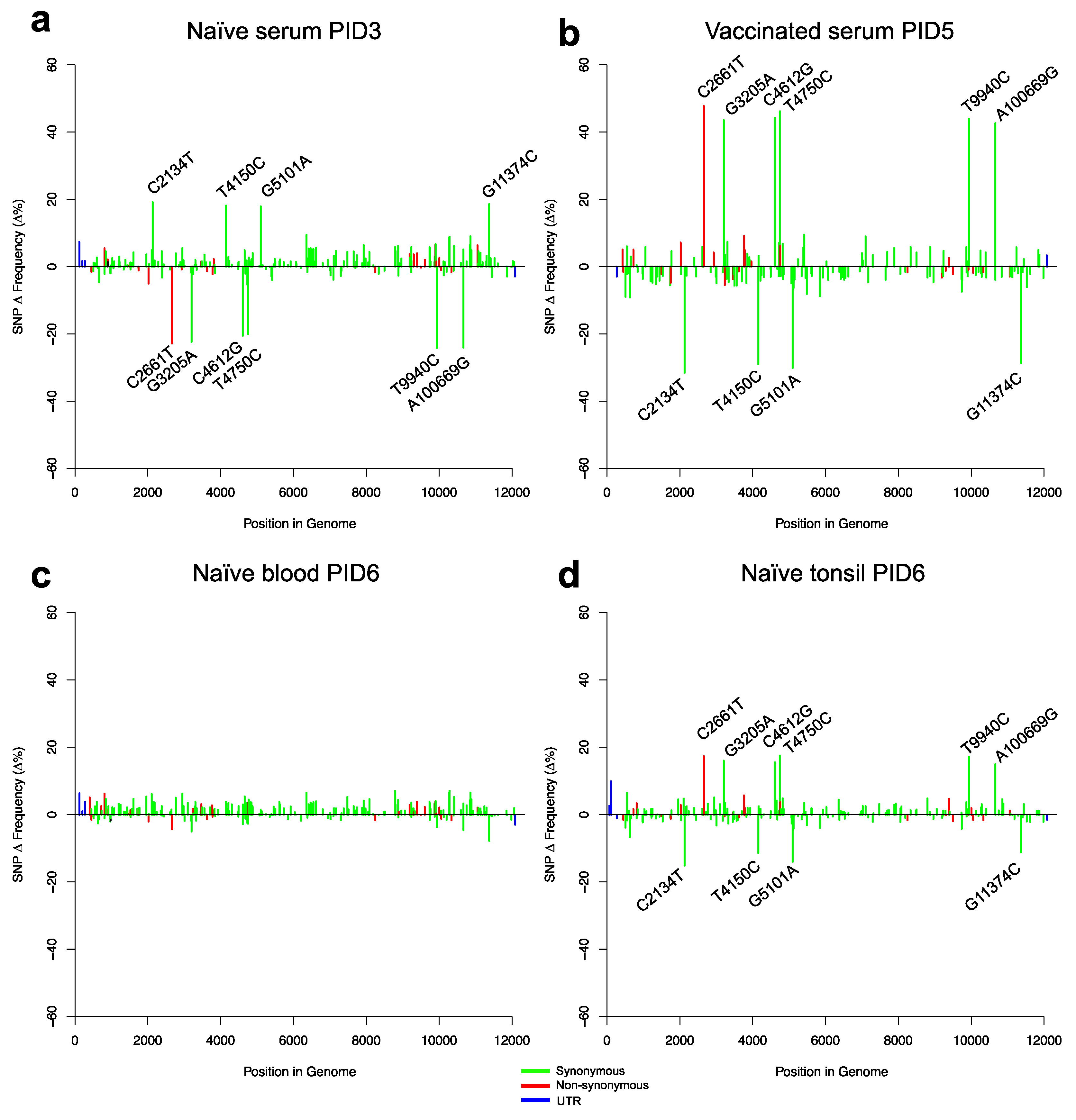
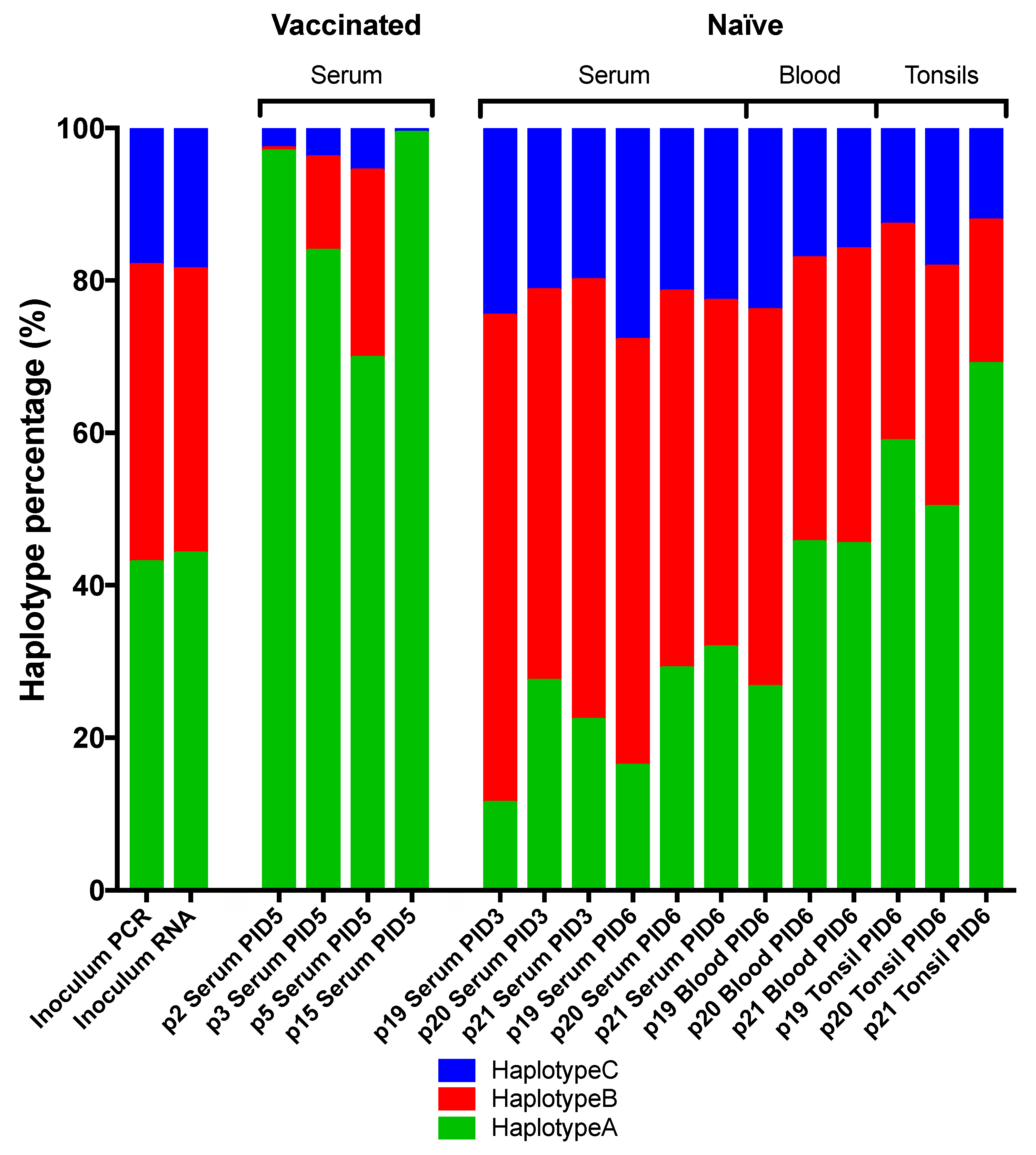
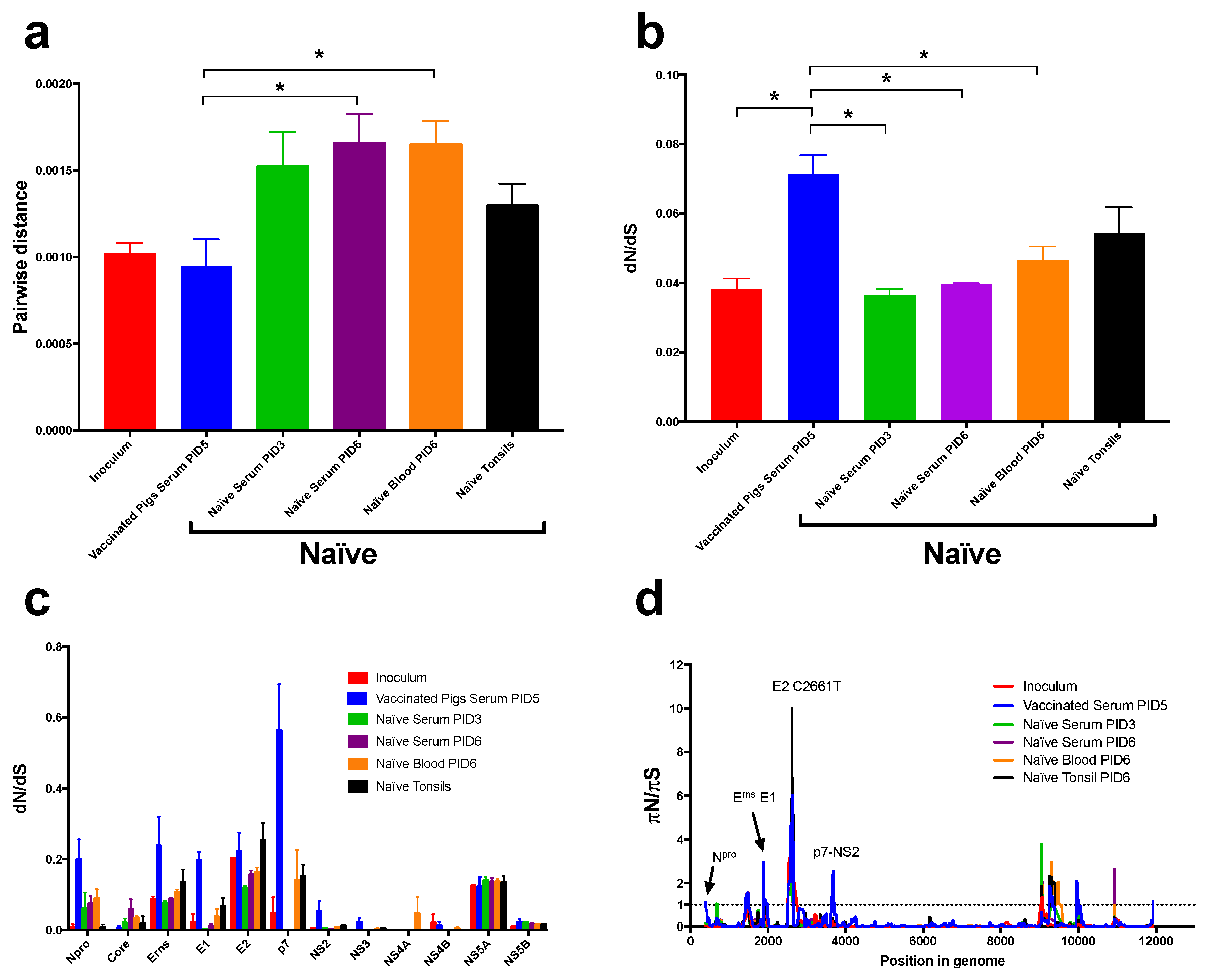
| Protein | Nucleotide Position | Inoculum (nt) | Variant (nt) | Vaccinated (serum) SNP Frequency % | Vaccinated (serum) SNP Frequency Δ % | Naïve (serum) SNP Frequency % | Naïve (tonsils) SNP Frequency % | SNP Effect | Comments |
|---|---|---|---|---|---|---|---|---|---|
| Npro | 425 | A | G | 5.1 | 5.1 | - | - | M18V | * |
| 547 | A | G | 6.1 | 6.1 | - | 6.4 | - | * | |
| 658 | C | T | 7.7 | 3.0 | - | 3.6 | - | ||
| 725 | A | G | 5.1 | 5.1 | - | 1.7 | I118V | * | |
| 814 | C | T | 3.1 | 0.6 | 1.3 | 1.5 | - | ||
| C | 1057 | T | C | 8.9 | 5.9 | 2.5 | 3.8 | - | |
| Erns | 1774 | A | G | 4.6 | 4.6 | - | 1.3 | - | * |
| E1 | 2024 | T | C | 13.8 | 7.2 | 1.52 | 9.4 | F551L | |
| 2395 | C | T | 6.6 | 2.6 | 0.7 | 5.8 | - | ||
| E2 | 2617 | T | C | 9.5 | 5.8 | 2.8 | 5.5 | - | |
| 2650 | T | C | 3.9 | 3.9 | - | 1.5 | - | * | |
| 2661 | C | T | 89.3 | 47.8 | 18.6 | 58.9 | S763L | ||
| 2935 | G | A | 6.7 | 4.2 | 1.65 | 3.1 | M854I | ||
| 3205 | G | A | 87.7 | 43.6 | 21.7 | 60.1 | - | ||
| 3244 | A | G | 6.5 | 3.5 | 0.6 | 6.4 | - | ||
| 3310 | G | A | 7.4 | 7.4 | - | - | - | * | |
| p7 | 3765 | A | G | 9.1 | 9.1 | - | 5.6 | K1131R | * |
| NS2-3 | 3782 | G | A | 8.1 | 5.1 | 0.7 | 5.1 | G1137S | |
| 3853 | G | A | 6.8 | 3.8 | 1.1 | 3.2 | - | ||
| 3907 | G | A | 2.9 | 2.9 | - | - | - | * | |
| 3931 | T | C | 1.8 | 1.9 | - | 2.0 | - | * | |
| 3965 | G | A | 1.5 | 1.5 | - | - | V1198M | * | |
| 4168 | A | G | 3.3 | 3.3 | - | 2.4 | - | * | |
| 4612 | C | G | 87.7 | 44.2 | 23.0 | 59.0 | - | ||
| 4729 | A | G | 15.2 | 7.2 | 2.7 | 9.2 | - | ||
| 4750 | T | C | 88.3 | 46.2 | 22.1 | 59.6 | - | ||
| 4760 | G | A | 6.2 | 6.2 | - | 3.6 | V1463I | * | |
| 4828 | T | C | 6.8 | 6.8 | 1.45 | 4.7 | - | ||
| 5248 | A | G | 6.0 | 2.2 | 3.0 | 3.4 | - | ||
| 5389 | C | T | 9.2 | 5.7 | 0.7 | 3.7 | - | ||
| 5416 | T | C | 15.4 | 9.5 | 1.9 | 9.3 | - | ||
| 6028 | G | A | 1.6 | 1.6 | - | - | - | * | |
| 7006 | G | A | 5.7 | 4.0 | 0.6 | 2.9 | - | ||
| 7021 | T | C | 5.1 | 1.9 | 0.6 | 5.7 | - | ||
| 7099 | A | G | 16.2 | 9.0 | 3.3 | 9.7 | - | ||
| NS4A | 7304 | T | C | 6.9 | 3.4 | 0.7 | 1.4 | - | |
| 7318 | A | T | 1.8 | 0.1 | 0.6 | 2.2 | - | ||
| NS4B | 7696 | T | C | 7.2 | 4.5 | 2.3 | 4.0 | - | |
| 7888 | T | C | 5.6 | 5.6 | 1 | 2.9 | - | ||
| 8341 | C | T | 9.5 | 5.9 | 1.4 | 5.0 | - | ||
| NS5A | 8500 | C | T | 6.0 | 4.2 | 0.6 | 3.4 | - | |
| 8878 | G | A | 9.7 | 5.8 | 1.2 | 3.7 | - | ||
| 9241 | A | T | 8.3 | 4.7 | 1.9 | 3.4 | - | ||
| 9396 | A | G | 7.8 | 2.5 | 9.2 | 9.9 | K3008R | ||
| 9871 | G | A | 5.8 | 5.9 | 1.4 | 3.6 | - | ||
| 9901 | T | C | 1.6 | 1.6 | - | - | - | * | |
| NS5B | 9940 | T | C | 85.7 | 43.9 | 17.6 | 59.2 | - | |
| 10259 | T | C | 4.8 | 4.8 | - | - | - | * | |
| 10402 | C | T | 6.9 | 4.3 | 1.3 | 3.1 | - | ||
| 10669 | A | G | 85.3 | 42.6 | 18.6 | 57.7 | - | ||
| 11242 | T | C | 5.7 | 5.7 | - | - | - | * | |
| 11452 | C | T | 5.4 | 2.3 | - | 6.1 | - | ||
| 11849 | C | T | 7.4 | 5.0 | 2.3 | 3.5 | - | ||
| 11872 | A | G | 6.5 | 3.5 | - | 4.0 | - | ||
| 3′ UTR | 12083 | C | T | 6.3 | 3.3 | - | 1.4 | - |
| cDNA * | C2661T | G3205A | T4150C | C4612G | T4750C | G5101A | Haplotype |
|---|---|---|---|---|---|---|---|
| (S763L) | |||||||
| P19_1 | + | + | - | + | + | - | A |
| P19_2 | + | + | - | + | + | - | A |
| P19_3 | + | + | - | + | + | - | A |
| P19_4 | - | - | + | - | - | + | B |
| P19_5 | + | + | - | + | + | - | A |
| P19_6 | + | + | - | + | + | - | A |
| P19_7 | - | - | + | - | - | + | B |
| P19_8 | - | - | + | - | - | + | B |
| P19_9 | - | - | - | - | - | - | C |
| P19_10 | - | - | + | - | - | + | B |
| P19_11 | - | - | - | - | - | - | C |
| P19_12 | - | - | - | - | - | - | C |
| P19_13 | - | - | - | T ** | - | - | C |
| P19_14 | + | + | - | + | + | - | A |
| P19_15 | + | + | - | + | + | - | A |
© 2019 by the authors. Licensee MDPI, Basel, Switzerland. This article is an open access article distributed under the terms and conditions of the Creative Commons Attribution (CC BY) license (http://creativecommons.org/licenses/by/4.0/).
Share and Cite
Fahnøe, U.; Pedersen, A.G.; Johnston, C.M.; Orton, R.J.; Höper, D.; Beer, M.; Bukh, J.; Belsham, G.J.; Rasmussen, T.B. Virus Adaptation and Selection Following Challenge of Animals Vaccinated against Classical Swine Fever Virus. Viruses 2019, 11, 932. https://doi.org/10.3390/v11100932
Fahnøe U, Pedersen AG, Johnston CM, Orton RJ, Höper D, Beer M, Bukh J, Belsham GJ, Rasmussen TB. Virus Adaptation and Selection Following Challenge of Animals Vaccinated against Classical Swine Fever Virus. Viruses. 2019; 11(10):932. https://doi.org/10.3390/v11100932
Chicago/Turabian StyleFahnøe, Ulrik, Anders Gorm Pedersen, Camille Melissa Johnston, Richard J. Orton, Dirk Höper, Martin Beer, Jens Bukh, Graham J. Belsham, and Thomas Bruun Rasmussen. 2019. "Virus Adaptation and Selection Following Challenge of Animals Vaccinated against Classical Swine Fever Virus" Viruses 11, no. 10: 932. https://doi.org/10.3390/v11100932
APA StyleFahnøe, U., Pedersen, A. G., Johnston, C. M., Orton, R. J., Höper, D., Beer, M., Bukh, J., Belsham, G. J., & Rasmussen, T. B. (2019). Virus Adaptation and Selection Following Challenge of Animals Vaccinated against Classical Swine Fever Virus. Viruses, 11(10), 932. https://doi.org/10.3390/v11100932






